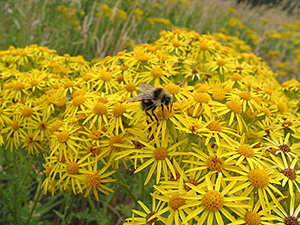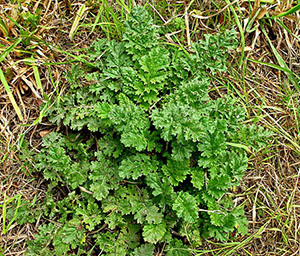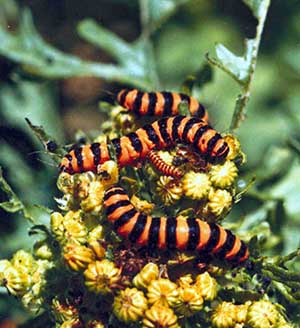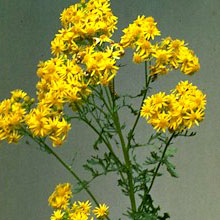— from Judy Jackson —
 It is tansy ragwort season again, one of the county’s worst weeds, and the plants are beginning to flower along roadsides, in fields and in residents’ yards.
It is tansy ragwort season again, one of the county’s worst weeds, and the plants are beginning to flower along roadsides, in fields and in residents’ yards.
Highly toxic, its alkaloids are present in all plant parts. Cattle, horses and goats consuming either growing plants or tansy ragwort in silage and hay store these poisons in their liver (Jacobs, J. 2009 USDA- NRCS). Even if symptoms are not noticeable, or appear minor, the cumulative toxins cause irreversible liver damage resulting in reduced weight, and possibly, sudden death in previously healthy animals.
Tainted dairy milk can have an off-taste, and contaminated pollen may make honey unpalatable. While horses and cattle will normally avoid tansy in pastures, it loses its characteristic odor when dry in hay, thus these animals are unable to distinguish it from the rest of the forage. Additionally, they can accidentally ingest leaves of the first-year rosettes when they are imbedded with emerging spring grass. Sheep are possibly immune from its toxic effects.
Also, please be aware tansy ragwort can also cause human liver damage, and should never be used as an herbal remedy or tea. Because of its threat to livestock, every effort needs to be made to find and eradicate this plant from pastures and hayfields.
 Tansy ragwort is easily recognized while it is in flower. No other locally common member of the daisy family has bright yellow flowers with thirteen petals (ray florets) and soft, frilly leaves, coupled with an unpleasant odor when crushed or pulled. Depending on the conditions, it may mature between a few inches to more than six feet in height.
Tansy ragwort is easily recognized while it is in flower. No other locally common member of the daisy family has bright yellow flowers with thirteen petals (ray florets) and soft, frilly leaves, coupled with an unpleasant odor when crushed or pulled. Depending on the conditions, it may mature between a few inches to more than six feet in height.
Mowing does not control Tansy. Plants will re-flower closer to the ground and, although normally a biennial, tansy ragwort will likely become a perennial when cut. A study of 179 plants in Australia found 2 percent were annuals, 45 percent biennials, and 39 percent were perennials. The seed life is about fifteen years.
Tansy is best controlled by pulling the entire plant out of the ground, but it is critical to remove the flower heads—if present—before discarding the rest of the plant. These heads should be bagged and taken to the solid waste facility, where they may be disposed of at no charge. If the heads are left on the plant, the seeds will mature and re-infect the area which is being cleared. This is especially important along roadsides where the flower heads and developing seeds can be picked up by tires and dispersed over great distances. Please remember to wear gloves when handling this toxic plant.
 You may see black and orange/yellow- striped caterpillars of the cinnabar moth, eating the leaves and flowers on some plants. If there are only a few found on the plant, we usually pull the plant and shake them off onto nearby tansy rosettes. If numerous caterpillars are defoliating the plants, we usually leave them alone. When ready to pupate, they leave their host plant, but unfortunately, the plants can re-flower and set seed even if completely defoliated.
You may see black and orange/yellow- striped caterpillars of the cinnabar moth, eating the leaves and flowers on some plants. If there are only a few found on the plant, we usually pull the plant and shake them off onto nearby tansy rosettes. If numerous caterpillars are defoliating the plants, we usually leave them alone. When ready to pupate, they leave their host plant, but unfortunately, the plants can re-flower and set seed even if completely defoliated.
For more information, please call the Noxious Weed Program staff at 376-3499. Many thanks for all of your tansy ragwort removal efforts over the years.
**If you are reading theOrcasonian for free, thank your fellow islanders. If you would like to support theOrcasonian CLICK HERE to set your modestly-priced, voluntary subscription. Otherwise, no worries; we’re happy to share with you.**







Thanks a “bunch” Judy! VERY informative article. If everyone would pull just a few plants it would help tremendously!
Maggie
We have been using a very successful spray on the smaller rosettes, and on the partial tansy that remains when the pull doesn’t get the entire plant.
1 gallon of white vinegar
2 cups Epson Salt
1/4 cup blue Dawn dish detergent
Put it in a spray bottle (share it — makes up about 10 spray bottles) and squirt away — hitting all the leaves. It takes a day or two before the tansy turns brown.
Smothering has been working too. This year we are going to try sawdust smother on the stubborn tansy.
Judy; A few years ago, for several years in a row, I patrolled a five mile section of roads (both sides) on Orcas and pulled out the Tansy that I saw blooming. I believe those roads to still be Tansy free.
So…. what is the County’s plans for eradicating the noxious weed? I see significant infestations of Tansy on County road easements as I drive around.
By the way, we are checking the Viewhaven neighborhood to see if there are any new plants to cull.
I am of the mind that the County needs to set the example!!